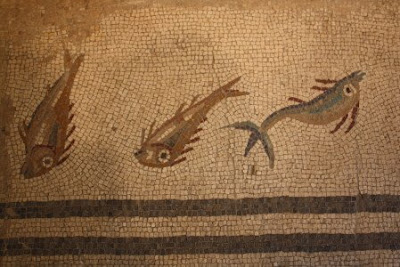Today Tarragona is a smallish city on the coast, but for the Romans it was the capital of Hispania Citerior, Nearer Spain. The Scipio brothers established their headquarters at Tarragona, or Tarraco as they called it, when they came about 218 BC to attack a nearby colony established by the Carthaginians. Within a decade Rome controlled most of the Iberian peninsula, and the city grew. In the first century AD Rome granted imperial status to Hispania Criterior.
The heart of old Tarraco was and is on a rocky outcropping by the sea, a sort of acropolis, surrounded by a wall (some of which predates the Romans). In the first century AD, Rome built an extensive complex of public buildings on this outcropping. Two large, adjoining public squares occupied most of the raised ground. The lower was a provincial forum with the administrative offices of the province and markets in the square surrounding an open area. The other, on higher ground, was dedicated to the “imperial cult” (according to a tourist brochure) with a Temple of Jupiter. Immediately below the provincial forum was a large Circus, and there was an amphitheater by the seashore. An aqueduct was built to bring brought water to the city. [A portion of the aqueduct remains about 3 miles outside the city, but we didn’t get out there.] Only traces of all this are left today, but those traces, and models of the layout, indicate how developed a Roman city this was.
Barcelona has its own Roman ruins -- remains of Roman walls and excavated building foundations. Compared to Tarraco, however, Roman Barcino was a minor town, little more than a fortified Roman camp, that was not established until considerably later, in the first century BC.
The train from Barcelona comes in along the sea, under the walls of the old city. We walked up the hill up to the old city, past part of the old city walls, and stopped first at the Archeological Museum. It has an impressive collection of Roman mosaics…

 Statutes…
Statutes…

 And everyday objects …
And everyday objects …Nearby is the largest group of ruins in the city, including a building that was one of the lower corners of the provincial forum (and in the 12th century was converted into a castle).
 The lower rooms of this building still show the barrel vaults of the provincial forum. Displayed in one of these is a carved sarcophagus (discovered nearby on the sea bottom in 1948).
The lower rooms of this building still show the barrel vaults of the provincial forum. Displayed in one of these is a carved sarcophagus (discovered nearby on the sea bottom in 1948). From the top of this building you can see a curved section of Circus seating to the right (the tower at left is from the 14th century).
From the top of this building you can see a curved section of Circus seating to the right (the tower at left is from the 14th century). The complex also preserves a long barrel vault that ran underneath one side of the Circus.
The complex also preserves a long barrel vault that ran underneath one side of the Circus.

Nearby, below the city walls by the sea, is what is left of the amphitheater (it was long used as a convenient quarry).
At the top of the old city is the cathedral, which was constructed, beginning in the 12th century, on the site of the Roman temple. We were not especially impressed with the cathedral itself, perhaps because it was undergoing extensive renovation and its best-known work of art, a 15th century altar painting, was partially obscured by a large diorama that had been installed as part of some celebration of Catalunya (other dioramas were installed in some of the vaults of the Roman ruins).
But we did enjoy the cathedral cloisters, which were very large with an interesting mix of styles: round Romanesque arches between columns collected in groups of three by pointed gothic arches set above panels with Moorish-influenced round opening and decorations.

 And a very nice Romanesque doorway connecting the cloisters and cathedral.
And a very nice Romanesque doorway connecting the cloisters and cathedral.At the end of the day we walked down to the modern waterfront, where there is a marina and the usual lineup of seafood restaurants. There also is a
 nice promenade with a series of interesting sculptures in shallow pools.
nice promenade with a series of interesting sculptures in shallow pools.Our day in Tarragona also included a necessary element of touring in Spain. All museums, monuments and churches were closed from about 1.30 to 4.30. So we found ourselves a nice restaurant and enjoyed a long, relaxing lunch. Adjusting to local customs can be very pleasant.















